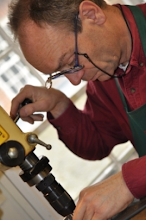 |
| loop-end springs in American clock |
The second lesson was that rebushing (and yes there seemed a great need for it judging by the enormous movement most of the arbors on both trains were allowed to make) is discouraged. I approached my West Dean tutor who kindly suggested that the frame of these American clocks is so wobbly that creating a well fitting bush will lock up the arbor and possibly even bend a pivot because the frame is bending under the force of the springs and so prevents a well fitting bush from offering sufficient room for a pivot to turn. The best advice is to accept the enormous room to manoeuvre in the existing bushes and drown it in oil.
Then I discovered that these clock movements can be bought new for about £60. So you wonder why am I repairing a clock while I can put a new one in for £60? The argument that there is emotional value in the clock always holds, but if a client sees a repair bill for many times the cost of a new movement you wonder if how long that argument will hold. Let's call this the third lesson learned.
While fiddling with the going spring to get it back in its place, I heard a loud crack and noticed (after a while) that the hole at the end of the spring that grips the great wheel arbor stud had split and now looked like the end of snake's tong. There was no way that the arbor stud was going to grab that spring end ever again. I cut off the end of the spring and created a new triangularly shaped hole for the stud to grip and had to do this twice, unfortunately, to get the right shaped hole. In the process, so much of the spring end was lost that what remained could not be convinced to engage with the great wheel arbor stud. So I decided to force it to engage which led to a further tear in the spring end. I admit that I annealed the spring end in order to create the triangular shaped hole. All according to the instructions of my West Dean notebook. But because the end of a spring after annealing is softer, it tears more easily, I suppose. Well, that is what happened and at this stage the spring was a write-off. There was no inner core left to grip. Cousins came to the rescue and will send me the new American spring American Ansonia 19 x .45 x 2500 x Ø47 (ANS19) x 1 @ £10.25 each. I feel this is not something I can charge the client for, despite the fact that I feel the spring was at its life end.
I learned my fourth lesson during reassembly of the movement. I struggled with the question "do you get the three wiry springs of the bell hammer, lifting piece and locking detent all in their place before or after putting the front plate on?" I found out (lesson four) that you must put the bell hammer spring in position before, and the other two springs after, you put the front plate on the pillars.
As my fifth lesson, I learned that the movement has a passing strike on the half hours. A cam on the centre arbor directly launches the bell hammer at 30 minutes past the hour. It also triggers the lifting piece on the whole hours. Interesting, I have not seen many of these passing strikes mechanisms yet.
My sixth lesson was that I observed that the countwheel, which sits on the striking train's great wheel, has two series of slots from 1 to 12. One series, of course, would be enough. I gather the reason for the two series of 1 to12 slots is to allow the great wheel to turn round in 24 rather than 12 hours. This allows to run the clock longer, as the great wheel can now turn half as fast compared to if there was only one series of 1 to 12 slots.
 |
| Countwheel with two times 12 hours cut out |
In the meantime, I am studying how to put the new going mainspring into the clock once it arrives! By logically deducing everything that is related to the main spring I can only conclude that we will have to wind the going train of the clock counter clockwise while the striking train will be wound clock wise. I have never seen such a thing and cannot believe my conclusion! A quick search on Google, though, on the words winding of American clocks opposite direction confirms my conclusion as correct. Why hasn't any clockmaker told me this? Somebody could have rung me and kindly explained that this is quite typical with American clocks.
I am now anxiously waiting for the postman who always so kindly says "sorry to disturb you" when I open the door in my TerKuileClocks apron, with my loop clipped to my clock glasses and my hands protruding in surgical gloves ready to receive the mail.

No comments:
Post a Comment